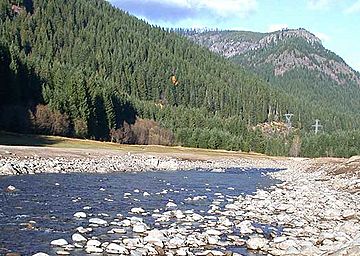Western Cascades facts for kids
The Western Cascades is a special area in Oregon, a state in the United States. It sits between the Willamette Valley and the taller High Cascades. You can also find parts of the Western Cascades in nearby Washington state. This region is full of old, inactive shield volcanoes, cinder cones (small, cone-shaped volcanoes), and hardened lava flows. The land here has been shaped a lot by nature, and it's covered in thick forests.
How the Western Cascades Were Formed
This area was very active with volcanoes about 35 to 17 million years ago. The Western Cascades are an older mountain range. They have been worn down a lot by weather and rivers. They lie to the west of the newer, snow-covered High Cascade Range.
The mountains here range from about 1,700 feet (518 meters) high on the west side to 5,800 feet (1,768 meters) on the east side. The Western Cascades started to form 40 million years ago. This happened when volcanoes erupted near the old Eocene coastline. Over time, the angle of the Earth's plates pushing together changed. This caused the volcanic activity to slowly move eastward during the Miocene and Pliocene periods.
The Western Cascades are mostly made of volcanic rocks that have changed a little over time. These rocks are from the late Eocene to the late Miocene eras. Erosion has cut deeply into these rocks. The only signs left of the many volcanoes that erupted here are occasional volcanic necks or plugs. These are hard rock formations that mark where old vents used to be.
There are also some newer lava flows from the Pliocene to Pleistocene periods. These flows came from the High Cascades or from rare local vents. The Western Cascade Range has four main types of rock layers, from youngest to oldest:
- Newest Lava Flows (0 to 4 million years old): These are basalt and basaltic andesite flows. They came from the High Cascade Range and filled old river valleys.
- Ridge-Capping Rocks (4 to 9 million years old): These rocks are basalt and basaltic andesite flows. There are also smaller amounts of andesite and dacite. These rocks form the tops of the highest Western Cascade ridges. They erupted before the land was lifted up and faulted along the eastern edge of the Western Cascades. These rocks are similar to the newest lava flows. They likely came from volcanoes in or near the High Cascades.
- Older Lavas (9 to 18 million years old): This layer includes basalt, basaltic andesite, and andesite lavas. It also has smaller amounts of dacite tuffs (volcanic ash) and lavas.
- Oldest Volcanic Rocks (18 to 40 million years old): This layer is made of silicic tuffs and lavas. The rocks in the two older layers (9 to 40 million years old) came from many volcanoes west of the High Cascade volcanic centers. Some of these older volcanoes might now be buried under the High Cascade Range.
Important Volcanic Vents
Here is a list of some notable volcanic vents (places where magma came out) in the Western Cascades:
| Name | Elevation | Location | Last eruption | |
| meters | feet | Coordinates | ||
| Armet Creek | - | - | - | ~0.56 million years ago |
| Battle Ax Mountain | - | - | 44°54′N 122°12′W / 44.9°N 122.2°W | 1-2 million years ago |
| Crescent Mountain | - | - | - | - |
| Harter Mountain | - | - | - | - |
| High Prairie | - | - | - | ~1.98 million years ago |
| Iron Mountain | - | - | - | - |
| Snow Peak | - | - | - | ~3 million years ago |
| Three Pyramids | - | - | - | - |


